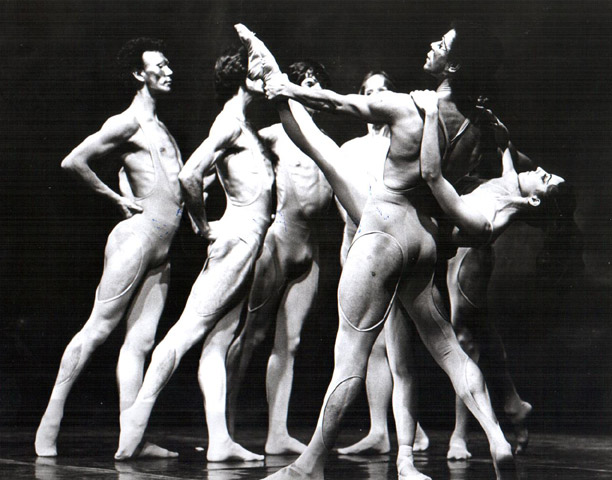Equus-Alberta Ballet
“ Alberta Ballet cast a spell over the Jubilee auditorium last night with an enticing brew. The showcase was “Equus”. This stark yet visually potent adaptation of the psychodrama by Peter Shaffer, choreographed and designed by the renowned choreographer Domy Reiter-Soffer.
Equus explores the deranged mind of young Alan Strang (Dennis Lepsi), who worships horses. In a mystic, erotic ritual, he viciously blinds a stable of thoroughbreds. Lepsi performance ripples with anguish of madness he is balanced well by Jay Brooker as Martin Dysart, especially in the twisted pas de deux that defines their power struggle. The half dozen dancers cast as horses have a proud stance and stride with pride. Almost gut wrenching moment is the red tinged chaos when Alan does the vile deed. It is a cacophony of wild movement, building to a soul-chilling climax, and extraordinary theatre and astounding end”.
(Anne Alexander-The Sun).
“Domy reiter-Soffer's “Equus” based on Peter Shaffer about a boy who undergoes psychotherapy after gauging the eyes of the horses he loves. The ballet does not avoid the play's premises about madness and psychiatry. Reiter-Soffer makes the story come alive in dance terms, and the cast helps him tell the story in vividly intense dramatic performance. The role of the psychiatrist is stylized; full of equine lunges and upward rearing prances. There is emotional dramatic truth to the relationship on which the ballet is built: between the boy and his psychiatrist danced by Dennis Lepsi and Jay Brooker respectively; the boy and his poignant cringing, melancholic parents, danced by Charice Barton and Andreas Bjorneboe, and the pretty groom and the powerful horse Nugget, danced by Barbara Moore and John Kellner. The duets between the boy and the groom, the other between the boy and Nugget communicate terror of the boy's growing acknowledgement of his adolescent sexuality. The psychiatrist awakening emotion is suggested convincingly. Memories and dreams, which include horses prancing is overpowering and spill effectively onto the stage. Equus is set to music by Wilfred Josephs with dramatic consequences. (Jennifer Dunning-the New York Times).
“The Horses in Domy Reiter-Soffer's Equus are so noble and so glossy; it is easy to understand how they ascend to god-like status in the mind of a troubled youth. The creatures are the triumph of this ballet, which ably captures the spirit of the Peter Shaffer play on which it is based. Represented by six male dancers in piebald leotards and gleaming body paint, the animals prounce proudly as ribbon-winning racers. One stallion named Nugget (John Kellner) stands out and captures the attention of Alan Strang (Dennis Lepsi) at the center of the ballet. The boy caresses the horse from mane to hoof with passion and drinks in the scent as greedily as if it were ambrosia. His attraction to the animal is both pious and sexual; when he kneels before the horse Alan's face rests on Nugget's thigh. Equus is about the result of Strang's fascination, and the bloody crime that has sent him to the psychiatrist in the scene that begins the ballet. To tell the story, Reiter-Soffer employs choreography that suggests emotions, rather than using literal mime. The psychiatrist (Jay Brooker) for instance, relays his openness with sweeping gestures, while Strang's restrained movement suggest insularity until his wonder at the glory of horses forces his body to open and thrust forward from the pelvis.
The tale unfolds before a set designed by Reiter-Soffer suggests glowering thunderclouds. Wilfred Josephs music have the same portentous feeling. Though the erotic symbol of the horses gallops through both the ballet and the play, the absent of text means the dance Equus must be appreciated on different terms. Riter-Soffer creation is more an impressionistic landscape of a horrifying situation than a detailed character study. Yet in his own way, the chorographer makes Alan Strang as compelling as he is in Shaffer's Play. With the help of the youthful and sensitive dancer Dennis Lepsi, Reiter-Soffer creates a teenage boy who is torn between the ties of family and the lure of freedom, between abject reverence and ecstatic sex, between the promise of reality and the immediate thrill of Fantasy”.
(Kate Zimmerman-Calgary Herald).
